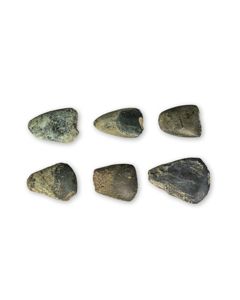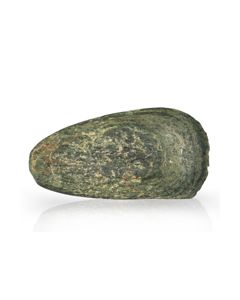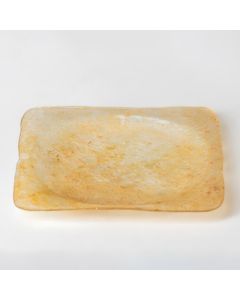Search results for: 'Art'
-
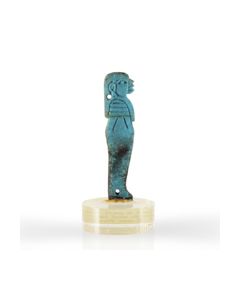 Appliqué of the Horus Son Imsety from Faiyum
Appliqué of the Horus Son Imsety from FaiyumMade of nice turquoise faience. Protective god responsible for the liver of a deceased. From the family of Lawrence of Arabia.
Price: on request Magnificent Egyptian feather crown
Magnificent Egyptian feather crownThe remarkable piece is a rare Henu crown, introduced as a pharaonic insignia in the New Kingdom. It dates from the 26th Dynasty and can close a difficult-to-fill didactic gap in an Egyptological collection.
Price: on request Sasanian gilt silver bowl
Sasanian gilt silver bowlMagnificent example of Sassanid craftsmanship of the highest quality. With a gilded bas-relief of a dancing woman in the tondo. Ex Sotheby's.
€38,000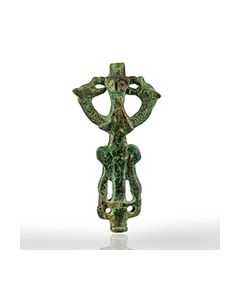 Luristan bronze standard with master of animals
Luristan bronze standard with master of animalsBronze finial from Iron Age Northern Iran. Decorated by stylized panthers and a janus headed hero or god. Possibly a teraphim, a house god, as referred to in the Old Testament.
€1,875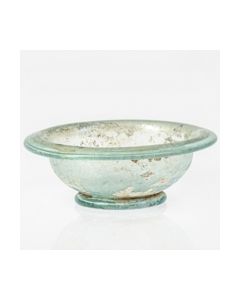 Roman glass bowl
Roman glass bowlThe nice bowl is made of pale blue green glass. It dates to the late Roman Imperial period.
Price: on request Mycenaean pottery stirrup jar
Mycenaean pottery stirrup jarCharacteristic type of vessel for the Mycenaean civilization in Bronze Age Greece. From the peak of Mycenaean pottery production in the 14th century BC.
Price: on request Hellenistic oil lamp manufactured in Asia Minor
Hellenistic oil lamp manufactured in Asia MinorHuman head in high relief on nozzle top, possibly a theater mask. Excellently preserved, from and old German collection, acquired in the 1960s - 1970s.
Price: on request Syrian amulet in animal shape
Syrian amulet in animal shapeSmall amulet of nice red stone in the stylized shape of a pig. From the 3rd Millenium BC.
Price: on request Etruscan Genucilla plate found in Tarquinia
Etruscan Genucilla plate found in TarquiniaA similar plate is on exhibition in the Metropolitan Museum in NYC. Excellently preserved, from an old German collection, acquired 1967 in Cologne.
Price: on request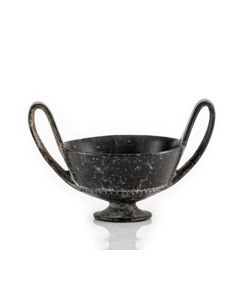 Etruscan Bucchero Kantharos found in Cerveteri
Etruscan Bucchero Kantharos found in CerveteriNicely preserved. From an old German collection, acquired in the 1960s.
Price: on request Bemaltes Gefäß aus der Bronzezeit
Bemaltes Gefäß aus der BronzezeitSphärisches Gefäß mit aufgemaltem Liniendekor. Möglicherweise als Kochtopf verwendet. Frühe bis Mittlere Bronzezeit. Ca. 3000 v. Chr. bis 1500 v. Chr.
Price: on request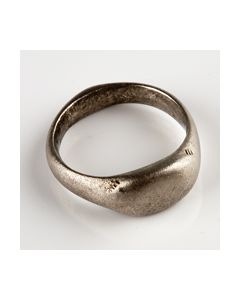 Römischer Ring aus Silber
Römischer Ring aus SilberRömische Kaiserzeit, möglicherweise aus der keltischen Provinz oder Provinznähe. Ringband geht nahtlos in die Ringplatte über. Theoretisch auch heute noch als Amulett oder Fingerring tragbar. Innendurchmesser 17mm bis 18mm.
Price: on request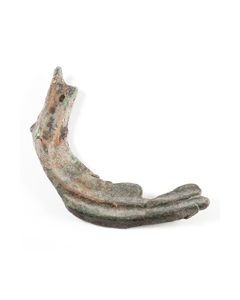 Bronzezeitliche Sichel mit Dekor
Bronzezeitliche Sichel mit DekorBronzezeitliche Knopfsichel mit fließend geformtem Sichelrund und Klinge mit interessantem Liniendekor. 2. Hälfte des 2. Jt. v. Chr., Europa.
Price: on request Bronzezeitliche Schüssel mit Kerbdekor
Bronzezeitliche Schüssel mit KerbdekorSchale mit Standfuß und Zierband aus äquidistanten Einkerbungen. Durchmesser 158 mm. Mittlere Bronzezeit II bis Späte Bronzezeit, 2000 bis 1200 v. Chr.
Price: on request Pfeilspitze oder Speerspitze aus der Altsteinzeit
Pfeilspitze oder Speerspitze aus der Altsteinzeit35.000 bis 30.000 v. Chr., Jungpaläolithikum. Letzte Phase der Altsteinzeit, Homo sapiens. Patinierter Flintstein mit deutlichen Bearbeitungsspuren.
Price: on request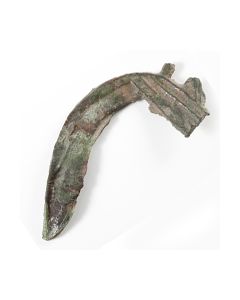 Bronzezeitliche Sichel mit Dekor
Bronzezeitliche Sichel mit DekorBronzezeitliche Knopfsichel mit fließend geformtem Sichelrund und Klinge mit interessantem Liniendekor. 2. Hälfte des 2. Jt. v. Chr., Europa.
Price: on request Pfeilspitze oder Speerspitze aus der Altsteinzeit
Pfeilspitze oder Speerspitze aus der Altsteinzeit35.000 bis 30.000 v. Chr., Jungpaläolithikum. Letzte Phase der Altsteinzeit, Homo sapiens. Patinierter Flintstein mit deutlichen Bearbeitungsspuren.
Price: on request Pfeilspitze oder Speerspitze aus der Altsteinzeit
Pfeilspitze oder Speerspitze aus der Altsteinzeit35.000 bis 30.000 v. Chr., Jungpaläolithikum. Letzte Phase der Altsteinzeit, Homo sapiens. Patinierter Flintstein mit deutlichen Bearbeitungsspuren.
Price: on request Pfeilspitze oder Speerspitze aus der Altsteinzeit
Pfeilspitze oder Speerspitze aus der Altsteinzeit35.000 bis 30.000 v. Chr., Jungpaläolithikum. Letzte Phase der Altsteinzeit, Homo sapiens. Patinierter Flintstein mit deutlichen Bearbeitungsspuren.
Price: on request Pfeilspitze oder Speerspitze aus der Altsteinzeit
Pfeilspitze oder Speerspitze aus der Altsteinzeit35.000 bis 30.000 v. Chr., Jungpaläolithikum. Letzte Phase der Altsteinzeit, Homo sapiens. Patinierter Flintstein mit deutlichen Bearbeitungsspuren.
Price: on request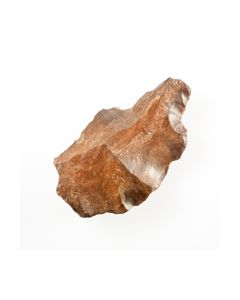 Pfeilspitze oder Speerspitze aus der Altsteinzeit
Pfeilspitze oder Speerspitze aus der Altsteinzeit35.000 bis 30.000 v. Chr., Jungpaläolithikum. Letzte Phase der Altsteinzeit, Homo sapiens. Patinierter Flintstein mit deutlichen Bearbeitungsspuren.
Price: on request Imposing elamite ceramic spouted jar
Imposing elamite ceramic spouted jarThe jar has a biconical body and a spout in form of a stilized bird's head. From ancient Iran at the beginning of the 1st Millenium BC.
Price: on request Roman gold earrings
Roman gold earringsTwo nice earrings made of gold wire, decorated by a convex round shield of gold sheet. Form the Roman Imperial period.
Price: on request Pair of Roman gold earrings
Pair of Roman gold earringsWonderful gold jewellery with shield and pendant with spiral decor. Made during Roman Imperial times.
Price: on request Mesopotamian stone vessel
Mesopotamian stone vesselHeavy and high quality vessel from Bronze Age of Mesopotamia, reminescent of similar Egyptian stone vessels. Ex Christie's.
Price: on request Roman glass beaker
Roman glass beakerRare cup made of almost colourless glass. A 4th century product from the eastern Mediterranean.
Price: on request Roman glass bowl
Roman glass bowlThe nice and small bowl is made of thick-walled glass. Possibly an Eastern Mediterranean made vessel.
Price: on request Ancient gold ring
Ancient gold ringMinimalistic circular finger ring made of nicely twisted gold wire.
Price: on request Red-figure Athenian shoulder Lekythos
Red-figure Athenian shoulder LekythosThe finely crafted decoration showing a maenad is in excellent condition, with only minor wear. An impressive miniature piece of art. In Swiss private collections since the 1960s.
Price: on request
 Six neolithic axe heads
Six neolithic axe headsGroup of six nicely crafted jadeite tools. From Stone Age southern France.
€600 Roman indented beaker
Roman indented beakerGlass beaker with pitting. A popular type across the whole roman empire. Mid 1st to 2nd century AD.
Price: on request Neolithic axe head
Neolithic axe headNicely crafted Stone Age tool made of wonderful light green jadeite. From southern France.
€330